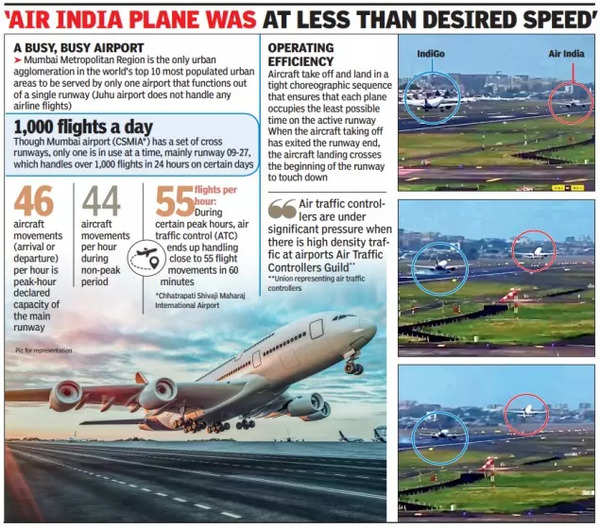MUMBAI: In a close call at Mumbai airport on Saturday, an IndiGo aircraft descended on the runway, touching down even as an
Air India flight
was taking off, breaching the safety margin. The Air India plane lifted off a split second before the IndiGo jet touched down about 2,100 feet behind, said sources.
At the busy Mumbai airport, which operates with one runway, the norm is that the aircraft taking off should lift off and cross the end of the strip before the aircraft landing can cross the beginning and proceed to touch down.
The incident, captured by plane spotters, showed the two aircraft, one behind the other, on the runway. On Sunday, the footage went viral on social media, prompting DGCA to initiate an investigation. From the angle the footage was recorded, the aircraft appeared dangerously close.
The investigation will primarily look into the sequence of events that led to the breach of separation, the safety margin, between the two A320Neo aircraft, one operated by AI as AI-657 from Mumbai to Thiruvananthapuram and the other, an IndiGo flight 6E5053 from Indore to Mumbai.
The runway meet-up of both these flights occurred around 6.20am. The air traffic controller concerned has been derostered from duty to allow for the investigation.

“The AI aircraft was cleared by the air traffic control (ATC) to enter the runway and subsequently cleared for take-off. The AI aircraft continued with the take-off movement in accordance with laid down procedures,” said AI in a statement.
The IndiGo flight from Indore was given landing clearance by ATC, a spokesman for the airline said. “The pilot in command continued the approach and landing and followed ATC instructions,” IndiGo said.
Though both airlines said their commanders merely followed ATC instructions, pilots and controllers TOI spoke to highlighted the role played by pilots and the system that forces them to operate in a constrained space in heavy traffic.
“The domino was triggered by the AI aircraft,” said air safety expert capt Amit Singh, based on data gathered from Flightradar24. Given the heavy air traffic on the lone runway, aircraft land or take off in a tight, choreographic sequence. The series of events that led to the incident occurred in the 90 seconds after an Iraqi Airways flight took off and the AI aircraft entered the runway for take-off. “The AI aircraft was slow to take-off after it received the line-up clearance, assuming they received immediate take-off clearance,” he said. They should have informed ATC, who would have cancelled their take-off clearance.
According to the Mumbai airport Aeronautical Information Publication (AIP), “when an aircraft is issued with a take-off clearance after lining up on the runway it shall commence take-off immediately. If the controller observes a delay in aircraft commencing take-off, the take-off clearance will be cancelled and the aircraft shall be instructed to vacate the runway immediately at the nearest taxiway.”
The AI aircraft had not lifted off when the IndiGo aircraft crossed the beginning of the runway (runway threshold with piano key markings is further down the line). AIP also provides rules for landings. “Aircraft shall not land on an occupied runway even if landing clearance is received,” says the AIP, listing a commander’s responsibility. “Pilot should not hesitate to ask ATC about traffic on the runway. If pilots perceive at any point that it is not safe to continue approach, they must initiate go around,” it adds.
Captain Singh said: “The question is the degree of responsibility on each of them, the controller and the two pilots and most importantly, the runway infrastructure constraints at the Mumbai airport which puts the controllers and pilots in such situations.,” he added.

